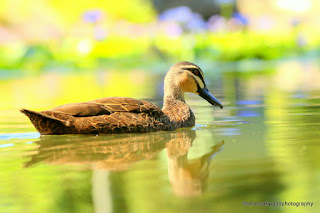Duck - Pacific Black Duck
 Despite being predominantly brown, the Pacific Black Duck has always been known as the ‘black duck’. Its only black plumage is a bold stripe that runs across the bird’s face, from its bill to behind its eye, giving it a distinctively striking pattern. It has been claimed that the duck appears as though it is black when seen at a distance. The species is known as the ‘Grey Duck’ in New Zealand, but as it has barely any grey plumage, this is hardly a more appropriate name!
Despite being predominantly brown, the Pacific Black Duck has always been known as the ‘black duck’. Its only black plumage is a bold stripe that runs across the bird’s face, from its bill to behind its eye, giving it a distinctively striking pattern. It has been claimed that the duck appears as though it is black when seen at a distance. The species is known as the ‘Grey Duck’ in New Zealand, but as it has barely any grey plumage, this is hardly a more appropriate name!
 Description
Description
The Pacific Black Duck is mostly mid-brown in colour, with each feather edged buff. The head pattern is characteristic, with a dark brown line through the eye, bordered with cream above and below and a dark brown crown. The upper wing colour is the same as the back, with a bright glossy green patch in the secondary flight feathers. The white underwing is conspicuous in flight. Young Pacific Black Ducks are similar to the adults in plumage.
Distribution
The Pacific Black Duck is found in all but the most arid regions of Australia. Outside Australia, its range extends throughout the Pacific region.
Habitat
The Pacific Black Duck is one of the most versatile of the Australian ducks. It frequents all types of water, from isolated forest pools to tidal mudflats. Pacific Black Ducks are usually seen in pairs or small flocks and readily mix with other ducks. In the wild, birds are often very wary of humans and seldom allow close approach. Birds in urban ponds become quite tame, however.
Feeding
The Pacific Black Duck is mainly vegetarian, feeding on seeds of aquatic plants. This diet is supplemented with small crustaceans, molluscs and aquatic insects. Food is obtained by 'dabbling', where the bird plunges its head and neck underwater and upends, raising its rear end vertically out of the water. Occasionally, food is sought on land in damp grassy areas.Breeding
Mating in Pacific Black Ducks coincides with availability of sufficient food and water, and often with the onset of heavy rains or when waterways are at their peaks. Courtship is accompanied by ritualised displays including preening, bobbing and wing-flapping. This behaviour is often initiated by the female, and, other than copulation, the male helps little in the breeding process. Often, two broods will be raised in a year. The number of offspring produced may seem quite high, but only 20% of these will survive past two years of age.







Comments
Post a Comment